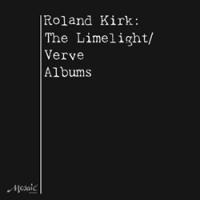Mosaic's Miraculous Roland Kirk Box Set
Anderson's "serenade" was a devilish, almost manic cover. Kirk's original is more whimsical and sly—almost "Pink Panther" Mancini-ish. That's not surprising since Kirk's work is humor-filled. He injects comic musical and vocal asides throughout these albums but especially on the first of the four, I Talk With the Spirits a happy confection of an album on which the multi-instrumentalist plays only flute. First issued on Limelight label in 1964, it's a breezy, fun-filled musical romp—so much so that by this point in Kirk's career, what with his playing three instruments simultaneously, many wrote him off as a novelty act. Wrong!
Kirk's breathy technique and his vocalizing while playing were wholly appropriated by Anderson who of course took the train to a very different station.
On this record made at the famous Nola's Penthouse studio Kirk plays three flutes (not simultaneously), backed by pianist Horace Parlan, bassist Michael Fleming and drummer Walter Perkins, with additional support from vibraphonist Bob Moses and vocalist C.J. Albert on a set of mostly originals. A standout is a cover of John Lewis's stately "Django" but honestly there's nothing that's less than a standout on this dreamy record that in some ways sounds like what The Incredible String Band might produce were it a jazz duo. Listen to the 1:17 second "Ruined Castles".
The sound of the original Limelight (a division of Mercury Records) was at best "okay". It sounded like a great recording locked in a sonic cage. Trust me when I tell you that Ryan K. Smith's remaster from the original tape opens the door and throws away the key! It's nothing short of miraculous, particularly the sound of the somewhat distance cymbals. Holy crap!
Kirk's second album Rip, Rig and Panic takes things in an altogether different direction as you might imagine, with backing by Jaki Byard on piano, Richard Davis on bass and Elvin Jones on drums. This one, recorded at Rudy Van Gelder's Englewood Cliffs, NJ studio January 13th, 1965 features Kirk on tenor sax, manzello (a Spanish soprano sax variant with a bent, flared bell), stretch (a straight alto sax with a large bell), castanets and a siren.
This album was my Kirk introduction thanks to a review in, I think, Stereo Review way back when, and it was a shocker. With Jones propulsion at work the set is off to a raucous start with "No Tonic Pres", a Lester Young tribute that has a line with no key resolution (thus the "no tonic" in the title). Rudy's piano sound is better than on the early Blue Notes but still not his strong suit with over modulation throughout. Byard breaks into some old fashioned stride-like key pounding, Kirk hits the castanets and the siren and you have both light-hearted fun and a pure strip-tease of an ending.
This album is a swinging, hard-boppish romp throughout with Kirk showing his"novelty detractors" that he was a serious player. He proves to be a superb balladeer on a cover of "Once in a While" and his multiple instrument playing on the bridge demonstrates that it's not a gimmick.
Another tribute tune "From Bechet, Byas and Fats" has Kirk at his serpentine sax best and by this point Rudy has Byard's pounding down in terms of where to set the levels but the piano sound remains the sonic weak point in an otherwise well-recorded set. If you have an original you'll hear the same tape dropout here near the conclusion of "Mystical Dream". Whatever caused it was there from the start and there was no going back into the studio for a fix.
Side two begins with the title tune on a moody, atmospheric experimental roll until the ensemble cuts in where it becomes somewhat more conventional in both mood and construction but it's still "way out" there in the best sense of the phrase. Rudy gets a "Blue Note" drum sound from Elvin, pushing the reverb across the room. The song ends with what sounds like a musical fist fight and a swirl of unidentified sounds.
"Black Diamond" is a lilting waltz number with Kirk on his manzello and Byard hitting block chords producing the effect of maybe Brubeck quartet on acid?
On "Slippery, Hippery, Flippery" Kirk employs pre-recorded, manipulated electronic sounds to add to his studio adventurousness: Spike Jones, meets Frank Zappa meets Roland Kirk (and with "Wild Goose" thrown in I will add Mickey Katz!). The tune concludes one of Kirk's recorded high points.
Again Smith's remastering works sonic miracles compared to the original Limelight. Yes, the overmodulated piano now is in all too clear relief but its worth it to get such great tonality and spaciousness from everything else.
The final two albums are not up to the high bar set by the first two and delve into more commercial realms but they are still worthwhile. Slightly Latin recorded at Capitol Studios, NY and issued on Limelight sounds at times something like Roland Kirk Meets Esquivel. Kirk's cover of "Walk On By" is a winner and his take on "And I Love Her" is equally effective.
Now Please Don't You Cry Edith another Van Gelder recording, this time for Verve and produced by Creed Taylor is also in a more commercial vein but Kirk's take on "What's It All About Alfie"? alone is worth the price of admission. Different than Sonny's but equally mesmerizing.
Four LPs superbly mastered by Ryan Smith at Sterling from the original analog tapes and pressed by QRP in Salina, Kansas will set you back $99 complete with excellent booklet in a box. This one, limited to 3500 copies is sure to eventually join the Mosaics going for big bucks online and in used record stores.
Highly recommended!




